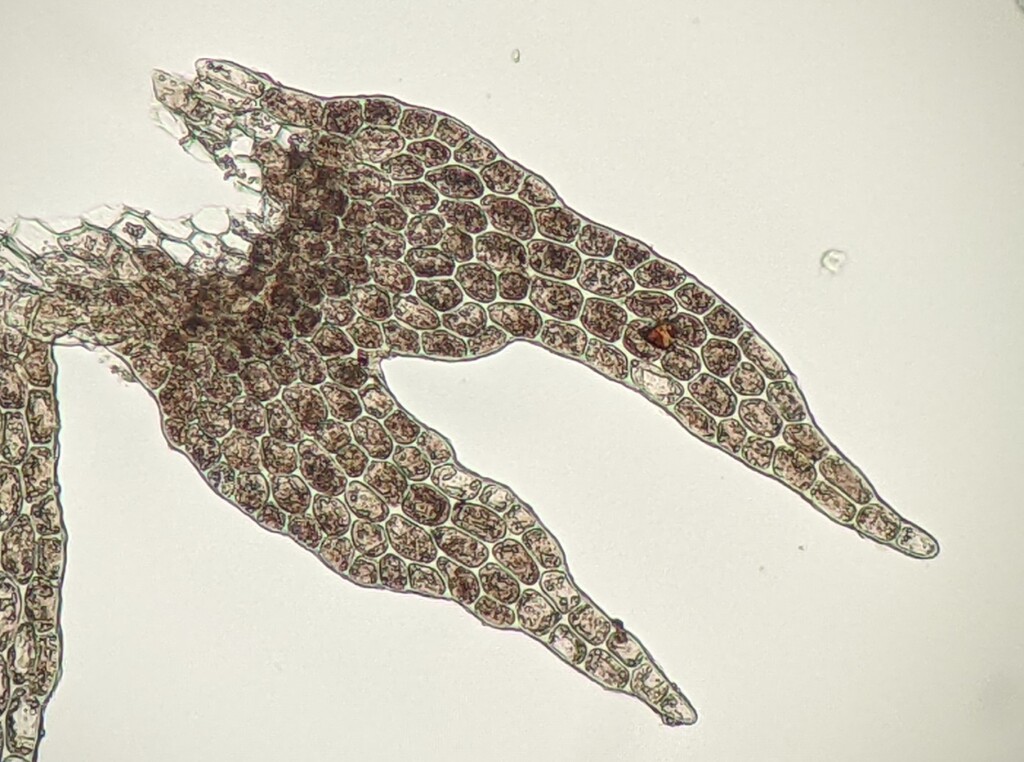Geocalycaceae
Terrestrial or on logs, autoicous. Asexual reproduction occasionally by 2-celled gemmae detaching from apices of reduced leaves at shoot apices (not in Victoria). Stems sparingly branched, with two ranks of lateral leaves and a third rank of underleaves; branches emerging from main stem near unmodified underleaf and with a collar composed of an unlobed ring of tissue at base, or rarely from near lateral leaf and without a collar of tissue at base. Lateral leaves succubous, alternate to almost opposite, imbricate to distant, flat or ascending, oblong-ovate to oblong in outline, with two or rarely lobes, entire; lobes ovate or triangular, acute. Underleaves smaller than lateral leaves, wider than stem, oblong to ovate in outline, shortly (not in Victoria) to deeply divided into two lobes, distant to contiguous, free or narrowly attached on one side to adjacent lateral leaf; lobes entire, narrowly triangular, diverging or more or less parallel. Leaf cells hexagonal, circular or oblong, finely papillose, thin-walled, with small trigones, with 5–25 oil bodies; oil bodies brown, spherical, granular-botryoidal or smooth (not in Victoria). Rhizoids at underleaf bases or scattered along stem, without peg-like internal thickening, hyaline. Androecia on short abaxial branches, with 8–20 saccate bracts, each with a single antheridium. Sporophyte forming within a pendent marsupium borne on very short abaxial branch without normal leaves, without a perianth; marsupium cylindric, subterranean, covered in rhizoids, with a crown of bracts close to stem. Capsule ellipsoid to cylindric, bistratose, dehiscing by 4 valves; elaters present, bi- or trispiral. Spores globose, minutely papillose, yellowish to reddish-brown.
One genus with four species, one in Japan, China, Nepal and India, one widespread throughout northern temperate regions, another from Reunion, and a final species, Geocalyx caledonicus Steph., occurring in New Caledonia, New Zealand, and southeastern Australia, including Victoria (Söderström et al. 2016; Schuster 2021).
The Geocalycaceae has been more widely circumscribed in the past to include unrelated genera now recognised in the Lophocoleaceae that produce perianths around the sporophytes (see Lophocoleaceae profile). Additionally, the Victorian genus Saccogynidium has also been included within the Geocalycaceae, which is also a marsupial genus with bifid underleaves, succubous lateral leaves and gametangia restricted to short abaxial branches. However, this genus was shown in phylogenies based on DNA sequence data to belong to another marsupium producing family, the Acrobolbaceae, with which it shares a multistratose capsule wall, unlike in the Geocalycaceae that have bistratose capsule walls (Shaw et al. 2015).
Schuster, R.M. (2021). Austral Hepaticae Part III. Nova Hedwigia Beiheft 120. Cramer in der Gebrüder Borntraeger Verlagsbuchbehandlung: Stuttgart.
Shaw, B., Crandall-Stotler, B., Váňa, J., Stotler, R.E., von Konrat, M., Engel, J.J., Christine Davis, E., Long, D.G., Sova, P. & Shaw, A.J. (2015). Phylogeetic relationships and morphological evolution in a major clade of leafy liverworts (Phylum Marchantiophyta, Order Jungermanniales): Suborder Jungermanniineae. Systematic Botany 40: 27–45.
Söderström, L., Hagborg, A., von Konrat, M., Bartholomew-Began, S., Bell, D., Briscoe, L., Brown, E., Cargill, D.C., Costa, D.P., Crandall-Stotler, B.J., Cooper, E.D., Dauphin, G., Engel, J.J., Feldberg, K., Glenny, D., Gradstein, S.R., He, X., Heinrichs, J., Hentschel, J., Ilkiu-Borges, A.L., Katagiri, T., Konstantinova, N.A., Larraín, J., Long, D.G., Nebel, M., Pócs, T., Puche, F., Reiner-Drehwald, E., Renner, M.A.M., Sass-Gyarmati, A., Schäfer-Verwimp, A., Moragues, J.S., Stotler, R.E., Sukkharak, P., Thiers, B.M., Uribe, J., Váňa, J., Villarreal, J.C., Wigginton, M., Zhang, L. & Zhu, R. (2016). World checklist of hornworts and liverworts. Phytokeys 59: 1–828.
 Spinning
Spinning